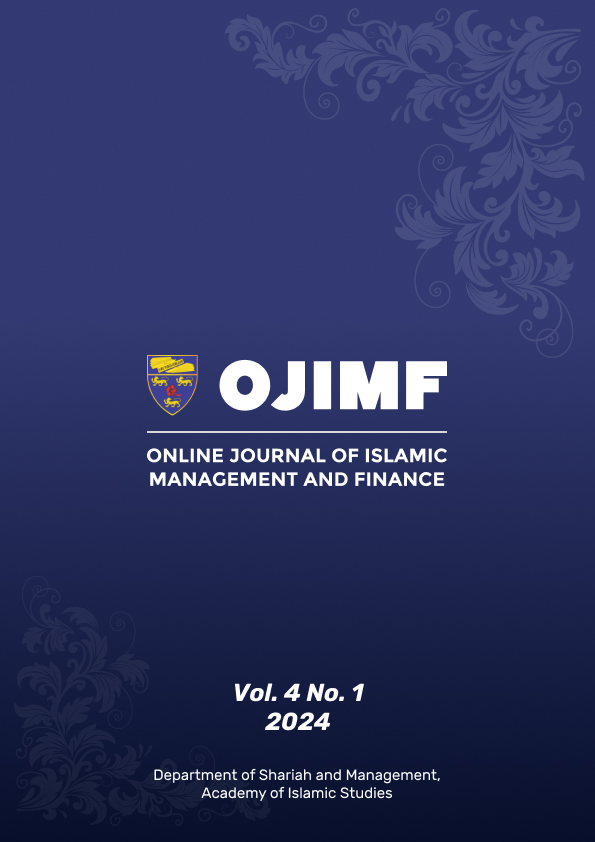أثر القيادة الاستراتيجية على تحسين جودة الخدمة (دراسة ميدانية في وزارة الأوقاف والشؤون الدينية بسلطنة عُمان) THE IMPACT OF STRATEGIC LEADERSHIP ON IMPROVING SERVICE QUALITY (A CASE STUDY IN THE MINISTRY OF WAQIF AND RELIGIOUS AFFAIRS IN THE SULTANATE OF OMAN)
Main Article Content
Abstract
This study aimed to identify the impact of strategic leadership in improving and developing the quality of service in the Ministry of Waqif and Religious Affairs in the Sultanate of Oman from the point of view of the ministry's employees. A sample of 249 employees in the Ministry of Waqif and Religious Affairs was randomly selected to answer questionnaire which is consisting of 57 items as a tool for data collection. Descriptive analytical approach and regression were used for entering, processing and analysing data. Results illustrated a good level of strategic leadership and quality of service in the Ministry of Waqif and Religious Affairs. The study also demonstrated the existence of a positive relationship between the five dimensions of strategic leadership and the quality of service provided in the ministry, ranging between medium and weak. Finally, results revealed that there was a significant effect of determining the strategic direction, supporting organizational culture and promoting ethical practices as dimensions of strategic leadership in the quality of service provided by the ministry, while the effect of the other two dimensions of strategic leadership (development of human capital and investment of strategic resources and capabilities) was weak and ineffective on Quality of service. The study presented many recommendations, including the need for all employees to participate in drawing up strategic policies and paying attention to attracting competencies and developing local capabilities working in the ministry and adopting strategic policies based on the latest electronic means and social media to reach the beneficiaries of the ministry's services in a more effective manner in implementation and achievement of Oman 2040 vision.
Downloads
Article Details
References
REFERENCES
Adair, J. (2009). Not Bosses but Leaders. How to Lead the Way to Success (3rd ed.). London: Kogan Page.
Agyepong, I., Lehmann, U., Rutembemberwa, E., Babich, S., Frimpong, E., Kwamie, A., Olivier, J., Teddy, G., Hwabamungu, B., & Gilson, L. (2018). Strategic Leadership Capacity Building for Sub-Saharan African Health Systems and Public Health Governance: A Multi-Country Assessment of Essential Competencies and Optimal Design for a Pan African DrPH. Health Policy and Planning, 33, 35-49. https://doi.org/10.1093/heapol/czx162
Al-Ansi, A. M., Hazaimeh, M., Hendi, A., Al-Hrinat, J., Adwan, G., & Garad, A. (2023). Innovative Responses to Exogenous Shocks in Indonesian Transportation Firms: Mediating Role of Sustainable Performance and Outcomes. Planning, 18(9), 2663-2672.
Al-Ansi, A. M., Jaboob, M., & Awain, A. M. S. B. (2023). Examining the mediating role of job satisfaction between motivation, organizational culture, and employee performance in higher education: A case study in the Arab region. Education Science and Management, 1(1), 30-42.
Alayoubi, M. M., Al Shobaki, M. J., & Abu-Naser, S. S. (2020). Strategic leadership practices and their relationship to improving the quality of educational service in Palestinian Universities. International Journal of Business Marketing and Management (IJBMM), 5(3), 11-26.
Ba Awain, A. M. S., Al-Ansi, A. M., & Jaboob, M. (2023). Green Supply Chain Management: A Comprehensive Review of Research, Applications and Future Directions. Management and Production Engineering Review, 14(3), 118-133. https://doi.org/10.24425/mper.2023.147194
Barzegar, Mehdi (2012) Relationship between Leadership Behavior, Quality of Work Life and Human Resources Productivity: 1(1), 1-14.
Boal, K., & Hooijberg, R. (2000). Strategic Leadership: Moving on. The Leadership Quarterly, 11 (4), 515-549. https://doi.org/10.1016/S1048-9843(00)00057-6
Guillot, W. (2003). Strategic Leadership: Defining the Challenge. Air & Space Power Journal, 17(4), 67-75.
Jaboob, M., Al Hadabi, D., & Al Ani, M. (2023). Evaluation of Dhofar University Performance according to Quality Assurance and Academic Accreditation Criteria of Islamic Universities Federation. Global Journal of Economics & Business, 13(4), 361–374.
Jaboob, M., Awain, A. M. S. B., & Al-Ansi, A. M. (2023). Sustaining employees’ creativity through the organizational justice: The mediating role of leadership styles. Social Sciences & Humanities Open, 8(1), 100693. https://doi.org/10.1016/j.ssaho.2023.100693
Jaboob, M., Hazaimeh, M., & Al-Ansi, A. M. (2024). Integration of Generative AI Techniques and Applications in Student Behavior and Cognitive Achievement in Arab Higher Education. International Journal of Human–Computer Interaction, 1-14. https://doi.org/10.1080/10447318.2023.2300016
John J. Sosik et al. (2005). The Strategic Leadership of Top Executives in High Tech Organization, Organizational Dynamics, 34(1), 47– 61
Musca, G., et al. (2016). A practice view of strategic leadership in highly risky and ambiguous environment: The Darwin expedition in patagonia. EGOS, 3(1), p. 3.
Othman, Baban Jabbar, and Mohd Lizam Mohd Diah. (2022). Impact of Knowledge Management and Strategic Leadership on the Competitiveness of the Real Estate Companies In Erbil City. Journal of Positive School Psychology, 6(4), 6444-6462.
QUIST, H. A. A credible leader for Turbulent times: examining the qualities necessary for leading into the future. Journal Strategic Leadership, 2(1), 12009
Ragul, V. (2021). Strategic Leadership And Service Delivery In Organizations: A Critical Review Of Literature. AfricArXiv Preprints. Doi: 10.14293/111.000/000022.v1
Rowe .W. G. (2001). Creating Wealth in Organizations : The role of Strategies Leadership, The Academy of Management Executive , 15(1), 81 – 94. DOI: 10.5465/AME.2001.4251395
Sebnem, A., Diken, A., & Sendogdu, A. (2011). Investigation of the Effects of Strategic Leadership on Strategic Change and Innovativeness of SMEs in a Perceived Environmental Uncertainty. Procedia-Social and Behavioral Sciences, 24, 627-642. DOI: 10.1016/j.sbspro.2011.09.009

